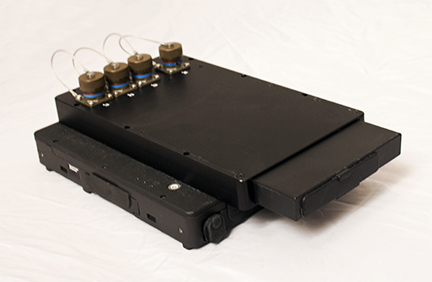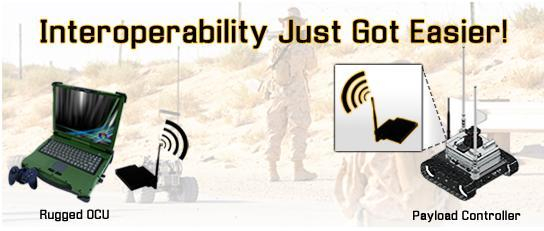Some of the big attractions at last month’s AUVSI North American conference were micro-UAVs. The Samurai UAV was especially impressive, sporting an unusual asymmetric design. You may have seen images of this amazing little device, but do yourself a favor and check out the video below of Engineering TV’s interview with Bill Borgia, Director of the Intelligent Robotics Laboratory at Lockheed Martin. Read more
Posts
 One of the hottest topics in the unmanned systems community is civilian applications. As Smithsonian.com reports in Drones Ready for Takeoff:
One of the hottest topics in the unmanned systems community is civilian applications. As Smithsonian.com reports in Drones Ready for Takeoff:
“The potential seems limitless—handling routine monitoring of pipelines and power lines, for instance, or gathering geomagnetic data about natural resources (a job that entails flying hundreds of miles in a straight line, at low altitude, then moving 50 yards over and flying straight back). Drones could help farmers monitor crops in distant fields, allow real estate developers to perform simple construction jobs in remote or difficult locations or enable environmentalists to spot polluters.”
 AMREL releases the first Payload Controller that uses swappable, field-expedient Radio Control Modules (RCMs). Radio components are integrated into the RCM, which fit into AMREL’s revolutionary swappable device bays. RCMs can be easily switched in and out by ordinary personnel, enabling it to easily change applications.
AMREL releases the first Payload Controller that uses swappable, field-expedient Radio Control Modules (RCMs). Radio components are integrated into the RCM, which fit into AMREL’s revolutionary swappable device bays. RCMs can be easily switched in and out by ordinary personnel, enabling it to easily change applications.
Developed under AMREL’s Flexpedient® Technology, RCMs were first used in AMREL OCU solutions. RCMs enabled AMREL to be the first company to produce an OCU solution that could control heterogeneous unmanned systems – even when they have diverse operating systems and different origins of manufacture. Read more
T here’s nothing quite like the prospect of a half of a billion dollars to get the blood pumping, the brain scheming, and the pundits pontificating. The President’s ambitious Advanced Manufacturing Partnership (AMP), which includes $70 million for robots, may not revive the American manufacturing sector, but it certainly has provided fodder for the technology media. Read more
here’s nothing quite like the prospect of a half of a billion dollars to get the blood pumping, the brain scheming, and the pundits pontificating. The President’s ambitious Advanced Manufacturing Partnership (AMP), which includes $70 million for robots, may not revive the American manufacturing sector, but it certainly has provided fodder for the technology media. Read more
Flexpedient® Technology enables one computer to run a variety of applications, including robotics and biometrics. This field-expedient system allows developers to protect proprietary technology while deploying it in an interoperable solution. To see just how simple it is, watch this video.
At a gathering of unmanned systems professionals, I heard a lot of griping about product development. Trying to deliver a system that the government wants was impossible, because of the time lag. Who knows what the Department of Defense would want or need 2 or 5 years from now? All participants in the meeting agreed that it was the governments’ fault. The Feds simply weren’t telling us what they wanted. Well, it’s not for the lack of trying. It seems every week there’s a new roadmap, report, vision, or long-term plan. I recently reviewed my personal collection of downloaded documents and came up with: Read more
griping about product development. Trying to deliver a system that the government wants was impossible, because of the time lag. Who knows what the Department of Defense would want or need 2 or 5 years from now? All participants in the meeting agreed that it was the governments’ fault. The Feds simply weren’t telling us what they wanted. Well, it’s not for the lack of trying. It seems every week there’s a new roadmap, report, vision, or long-term plan. I recently reviewed my personal collection of downloaded documents and came up with: Read more
Ground Robotics Capabilities Conference 2011 Report
Mike Castillo, AMREL’s Senior Architect for Robot Applications, just came back from the Ground Robot Capabilities Conference with all sorts of news.
“Research and development is out,” he reported. “Budget priorities have changed. DoD wants existing technologies with a small form factor that’s light and available right now.”
This news made AMREL happy since our product line is mature and even our new solutions are based on proven technologies. For example, at the conference, we successfully demonstrated our new payload controller. Based on the battlefield-tested Flexpedient technology, this payload solution is the first one with interoperable capabilities.
Future blog posts will feature more news about this year’s conference, our new payload controller, as well as other new AMREL solutions.
For more information about Flexpedient and interoperable solutions, watch the video on the Flexpedient page.
AMREL at the Ground Robotics Capabilities Conference
March 22 – 24, 2011 – Orlando, Florida – Booth #112

Flexpedient® Technology now extends existing radio modules’
capabilities to both our OCUs AND payload controllers
Come see AMREL’s latest platforms, including:
- New 986 series laptops with standard Flexpedient device bays
- Atom-based handheld computers & OCUs
- Up-to-minute OCU form factors
To find out about AMREL’s hospitality suite, contact Mike Castillo at:
Office: (626) 443-681, ext 190
Cell: (626) 482-8791
Email: michaelc@amrel.com
In “UAV Implementation at the Infantry Platoon Level” (Military & Aerospace), the author reported “I spent 2 ½ years over 2 deployments to Iraq as an Infantryman and we rarely had good UAV support. When we did have UAV support, it was not always ‘top of the line’ because the operators were FOB based and it was an office job that became a ‘check the block’ duty.” The author complained that UAVs were not being “pushed down to the platoon level,” because “…most Commanders are concerned about losing platoon level UAVs.”
His comments about the implementation of UAVs are an interesting example of how Human Robot Interaction (HRI) difficulties frustrate the proper implementation of novel technology. From the very beginning of the introduction of unmanned systems into the battlefield, there has been a debate about the best positioning of human operators. For the most part, a consensus has emerged that the dangers posed to operators in the front lines are outweighed by the advantages of close coordination with forward-placed warfighters.
In this instance, UAV deployment was influenced not by concerns about the operators, but–according to the author- by fear of losing valuable equipment. Clearly, these commanders hadn’t gotten the memo that the point of unmanned systems is to assume risk, so the troops don’t have to.
Livescience.com in “Real Soldiers Love Their Robot Brethren” reveals that other soldiers also haven’t gotten this memo. Quoting Peter Singer (author of “Wired for War: The Robotics Revolution and Conflict in the 21st Century”), they describe a “… soldier who ran 164 feet under machine gun fire to retrieve a robot that had been knocked out of action.”
The phenomenon of soldiers risking their lives for robots was also reported in “Why Bomb-Proofing Robots Might Be a Bad Idea” (Wired.com). In fact, the author of that article suggests that we should reconsider the ideas of outfitting robots with expensive classified electronic countermeasures, because that “…undermines the purpose of having a disposable army of machines to handle irregular war’s most dangerous work.”
So, in addition to obstructing proper implementation, HRI difficulties affect actual combat. A great deal of research has been done on HRI, but human behavior has a way of confounding even the most dedicated researcher.
Even the User Interface (UI) itself can cause unanticipated problems. In an article to be published in the March OCU Pros newsletter, David Bruemmer, VP of R&D at 5-D Robotics reveals some unexpected problems with commonly used UIs. Simply put, video feeds and other information-rich UIs may actually be detrimental to the operation of an unmanned system (To read this article and receive the OCU Pro newsletter, sign up here).
The unpredictability of how humans interact with robots may frustrate the drive to field novel technology as fast as possible. This obstacle emphasizes the rather unsurprising idea that end-user input is important early in the development process (At least it should be unsurprising to anyone who reads this blog).
Of course, not all unpredictable human interactions with robots have dire consequences. Check out this video of a “weaponized” BigDog robot being used in ways that the designers surely never envisioned.
Popular Science has an article about applications developed for military robots that may find use in the civilian world. One of the spotlighted applications utilizes an AMREL computing platform. Created for iRobot’s PackBot, it allows command and control of unmanned systems, even when there is interference by urban buildings. This customized solution is one of many that leverages the flexibility of AMREL’s computers. Check out “7 Military Robots, Now Modified for Your Living Room.”
For more information about how AMREL computers are used for the PackBot, visit the “Deployed Solutions” section in our Robotics website.
American Reliance, Inc.
789 N Fair Oaks Ave,
Pasadena, CA 91103
Office Hours
Monday-Friday:
8:00 am – 5:00 pm PST
Saturday: Closed
Sunday: Closed
Main: +1 (626) 482-1862
Fax: +1 (626) 226-5716
Email: AskUs@amrel.com
Blog Posts
Mobile Biometric Solutions
Mobile Biometric Smartphones & Tablets
BioFlex S® Commercial Smartphones
BioSense AT80B | 8″ Android Biometric Tablet
BioSense PA5 | 10.1″ (Gen 2) Android Biometric Tablet
BioSense PA5 | 10.1″ Android Biometric Tablet
BIOPTIX PM3B | 7″ Windows Biometric Tablet
BIOPTIX PM5B | 10.1″ Windows Biometric Atom Tablet



